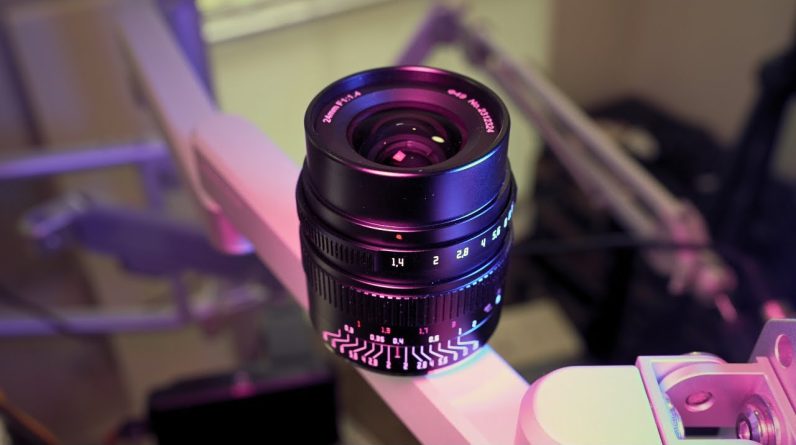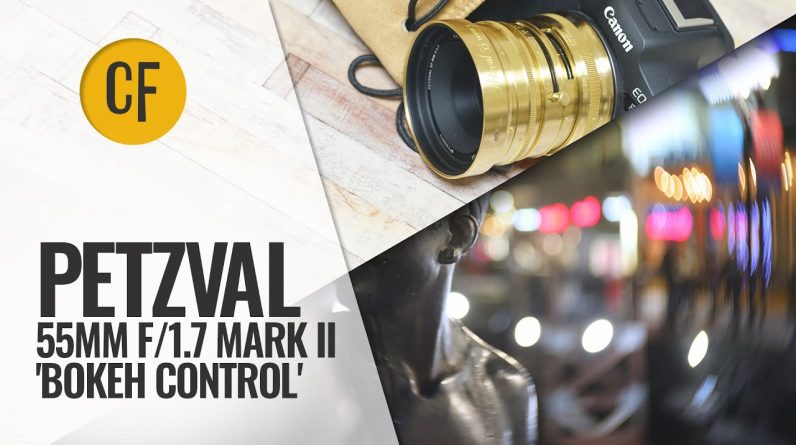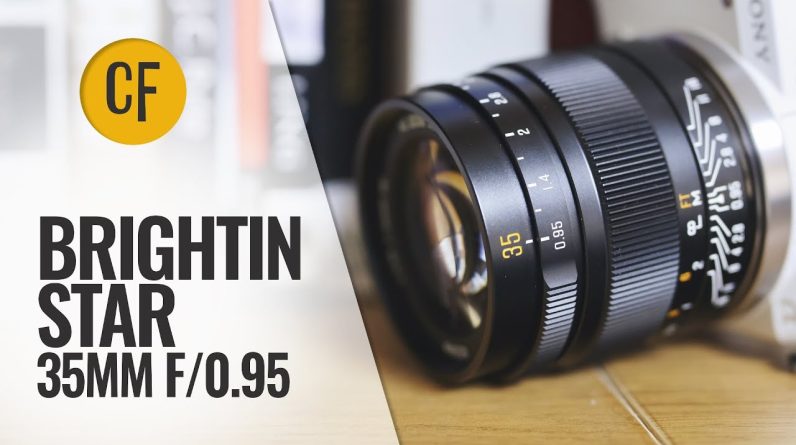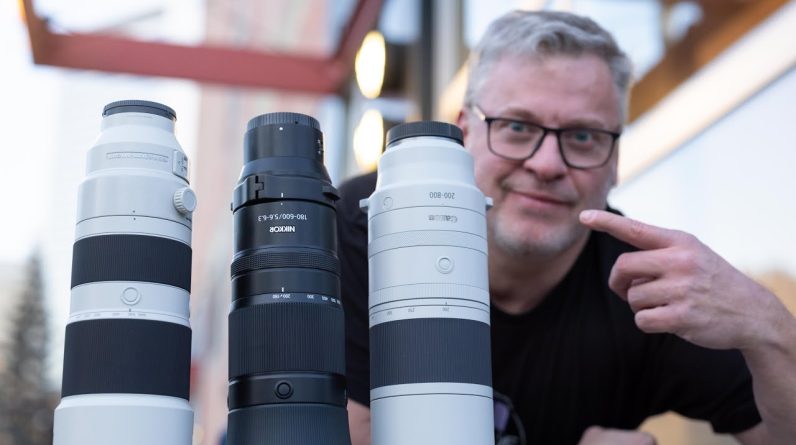This is the a7R V, Sony’s
latest full frame camera. It’s like an a7R IV sensor,
with alpha 1 video aspirations, Wrapped up in an a7 IV body, But with a new tilt/flip screen mechanism That’s not only the best I’ve ever seen, But that makes the rest of my cameras Seem clunky and limited by comparison. Let’s get undone. ♪ Gerald Undone ♪ ♪ He’s crazy ♪ – What’s happening, everybody? I’m Gerald Undone and I’m on
the highway to the dangerzone. For disclosure, Sony lent me this camera To make this review, I
do not get to keep it, No money changed hands, and
Sony does not get any input On this video’s production
or get to preview it Before it’s posted. This video does have an
actual sponsor though And that’s Nebula and their
partner Curiosity Stream. So at the risk of overselling
this screen mechanism, Let’s start there, because I’m obsessed. It’s like the Panasonic S1H screen In that it combines a tilt layer With a fully articulating one. However, unlike the S1H
screen, this is much thinner, And not only tilts up, but also down, Which were the major
drawbacks of that S1H display. In fact, this screen actually
comes completely away From the body, not only
improving its maximum tilt range But helping with heat dissipation. And while away from the body,
it’s still sturdy enough To allow for easy rotation
of the flip out portion. It’s truly outstanding and
I hope all future cameras From Sony use this
mechanism moving forward.
The rest of the body, as I said, Feels identical to the a7 IV, Except that this has a flash sync port Behind the full-size HDMI door. But just like the a7 IV, This camera has all the new stuff too, So the photo/video/S&Q lever, The new menu with the focus
breathing compensation, Focus map, easy 1080p60 streaming
over USB-C, 10-bit color, S-Cinetone, and even the new
Main at-a-glance menu pages That we saw on the FX30
and FX3 2.0 firmware, Including the FX30’s new video
on-screen display elements That are framed better
around the 16×9 image, Which I’ve really come to appreciate. Just little things like
always being able to see My battery life without needing
to clutter my whole screen With the rest of the elements
makes a huge difference. And it also comes with the
shutter sensor protector That we’ve seen in the last
few models from Sony as well. The a7R V basically has everything That Sony has put in
their different cameras In the last couple years, but
all at once, which is nice. It’s still a 61 megapixel sensor Just like the previous a7R IV, But with a new autofocus
system and improved IBIS. It also uses the newer
processor from the alpha 1, Which Sony claims is 8X faster
than what was in the a7R IV, Which means we’re getting a
lot more recording options. As I mentioned, we have
10-bit across the board now, And we can record that
all the way up to 8K At 24 frames per second. You can also record 4K up
to 60 frames per second, And then oversampled 4K at 24
and 30p in an APS-C crop mode. And it’s here that we’re gonna
see the biggest difference
Between this camera and
something like the a1, Which also does 8K. This sensor just isn’t as
fast and some compromises Had to be made to achieve
all of these resolution And frame rate combinations, And my biggest complaint about this camera Is the somewhat complicated
cropping, binning, And oversampling pipelines
that when combined With the added crops from
things like active stabilization Made it so that I had hard time telling What my true focal length
was most of the time. So for example, to get a true full frame, Full width, uncropped image, You have to shoot 4K up
to 30 frames per second. This will create an
image that is binned down From an over-8K sensor. This binning method is solid though, It’s the same one used on the alpha 1, And I found that image to be just as good As the a7S III’s slightly
oversampled 4K image. Now from here you can
switch to 4K60 if you want, Which unlike the a7 IV, doesn’t
force you into an APS-C crop And instead puts a 1.2x
crop on that full sensor To bring it down to just 8K, And then bins what’s left down to 4K At 60 frames per second. I assume they needed to do this To be able to readout the
4K fast enough for 60p, Because 4K120, isn’t even
an option on this camera. So 4K60 has a 1.2x crop. And the 8K24 comes from that
same 1.2x crop 8K image, But instead of binning it down to 4K, They just deliver the 8K image At a maximum of 24 frames per second.
However, it gets more complicated As you can also switch
to APS-C voluntarily, Which will crop in 1.5
times to a 6.2K portion Of the sensor and oversample
your 4K recordings From that 6.2K resolution, But you can only do this
up to 30 frames per second. So there’s no APS-C 60p on
this camera, unlike the a7 IV. So between all these modes You have a full range of capability, It just requires a bit of
work to keep track of it all When you’re busy focused on your shoot. And this is the major
advantage that the a1 has Over this camera. Because the alpha 1 is so fast, You can just shoot anything and everything In full frame with no crops and no fuss, All the way up to 8K30 and 4K120. But the a1 is $2500 to $2600
US more than this camera, So the price difference
makes the a7R V’s compromises Seem quite reasonable. Naturally though, I shot
my chroma subsampling chart To make sure there was
nothing weird going on With the binning and oversampling, And I’m happy to report that the quality Is as expected between
the different modes, And the binning looks good. Here in the 8K recording You can see the individual blue pixels Between the bands of red, and
this detail is well preserved When looking at the 6.2K oversampled APS-C recordings as well. When moving to the 4K24
full frame binned recording, We can see the pixel groups
getting larger and conjoined, But still keeping the distinct pattern,
And then finally when moving to 4K60, Which has it the worst being
both cropped and binned, We see that we lose a bit more detail, But again, still preserving
the color information And most of the boundaries
between blue and red. And this is at over 400% magnification. When we pull back to even 200%, I find it hard to tell the
difference between them. So this is all handled
well, just like the alpha 1. Of course, rolling shutter
is gonna take a hit When compared to the a1’s stacked sensor, And the results are basically an inversion Of the previous detail rankings. So the worst offenders for rolling shutter Are the 8K and oversampled APS-C modes, These are gonna give you results closer To the problem rolling
shutter being a7 IV, Although this camera
might be slightly faster, But still quite a bit of jello. If we switch over to the
binned full frame 4K, however, We get a better result with
considerably less warping During pans, which is
improved a bit more still When moving to 4K60. These binned readout
speeds are quite acceptable In my opinion, and the
rolling shutter effects Are tolerable in these modes. Now I also went through
and tested the battery life And overheating during each
of those readout methods. For each test I used a
fully charged FZ100 battery, The same battery you’d find In any Sony full frame mirrorless camera Over the last few years, and
the ambient temperature During the test was 23
Celsius or 74 Fahrenheit. The camera’s temperature
threshold was set to high
And the screen was pulled
out and away from the body. For the 8K24, I recorded 1 hour 34 minutes Before the battery died
with no overheat warning, But the camera became
extremely hot to the touch. I couldn’t hold the camera at that point For longer than a minute without
it getting uncomfortable. In 4K60, I got 2 hours 25
minutes before the battery died, Again no overheat warning. This time it was warm to
the touch, but far cooler Than the 8K recording
and it felt fine to hold. Then for 4K24 oversampled APS-C, It lasted for 2 hours 10
minutes before the battery died, Still no overheat warning. It was quite warm this
time, warmer than the 4K60, Holdable, but almost too hot to hold. Then lastly, the 4K24 Binned Full-Frame Gave the longest battery
life of 2 hours 33 minutes, No overheat warning, And this time it was barely
warm to the touch. So no concerns in that mode. Now these results are
based on my experience In my environment. Your results may be different. Sony rates their heat
dissipation at 30 minutes Of 8K recording. I assume those are on the safe side, But that’s what they’re advertising. Now when it comes to actually
recording these files, It uses the same dual-double
slots of the last few cameras With two CFexpress Type
A and two SD card slots. And all the same codec
options are available Including H.265 and All-Intra. I also tested the dynamic
range in each of those modes. Now, considering we’re
using a similar sensor
To the older a7R IV, I was expecting to see worse dynamic range Than cameras like the
a7S III, a1, and a7 IV, And my expectations were correct, But improvements elsewhere in the camera Allowed us to regain some of that loss. For example, now that we have 10-bit We can confidently record in S-Log3, Which will provide some
improvement over the gammas That were better suited to 8-bit cameras, And the 8K recording allows
us to capture a finer noise, Which is easier to hide
and less noticeable When left in your shots. So starting with that 8K image, We captured 14.9 total
stops on the Xyla 21, Which is reflected here in Imatest Beside the words Slope-based DR. This is the total amount of patches That the sensor could see, But not necessarily good clean stops. So instead let’s look
at the 0.5 Medium score, Which tells us how many
stops have a usable, Signal to noise ratio of two. And for the 8K recording we get 11.7 stops When viewed on an 8K timeline, Which isn’t too bad at all
honestly, for a sensor like this. But if we take that 8K image
and drop it into a 4K timeline, Giving us an improved,
downsampled 4K image, We get a bump up to 12.4 stops, Which is a solid result and
a worthwhile improvement If you have the cards and
hardware to work with 8K footage. If instead you opt for
the binned 4K in-camera, You can expect about 11.8 clean stops, And slightly worse if you
shoot in 4K60 at 11.5.
And then lastly, if you shoot
the oversampled APS-C 4K, You can get 12.2 stops
right out of camera. Again, no big losers
anywhere regarding the modes On this camera. Everything makes sense and is
reflective of earlier tests. There are avenues and
combinations within this camera To produce an optimal result, But the binned 4K is a
reliable option with no crop, Better rolling shutter
and decent dynamic range. It has a lower potential quality ceiling, But it’s a great option for a
no-fuss shooting experience. But let’s take a closer
look at that noise. When shooting in S-Log3, the
camera has a base ISO of 800, But it appears to clean up at ISO 2500, Which is where I would
place it’s unofficial Second native ISO. It has a maximum standard ISO of 32,000, And I found it usable even at ISO 12,800, But I would avoid pushing
it to 25,600 when possible. This isn’t what I would
call a low light specialist, But you can count on it In most reasonable situations when needed. And thankfully there are
no noticeable hue shifts Or color issues even when
shooting as high as 25,600. Color accuracy is superb
and you can easily mix shots With an alpha 1 or a7 IV. I did, however, find this a7R V To be slightly more saturated
than the a1 when matching, But bumping the saturation
a few points on the a1 Made the shots look almost identical. It was also during this test That I was able to see
a practical difference In the dynamic range between these cameras When I purposely clipped the highlights
In the skintones equally on each. After recovery you can see the alpha 1 Retained slightly more of
the face than the a7R V did. The differences are small, but
the a1 is slightly superior In this regard, and you’d
see a similar result If you compared this
new camera to the a7 IV, Which also outperforms
the R V in this aspect. But I’d be lying if I said
I didn’t like the bold, Saturated colors of this sensor. I took it on a bit of an autumn photo walk And was quite happy with
how rich the images were After using only a basic S-Log3 transform. And while on that walk, I also got a chance to test
out the new IBIS system On this camera. Sony claims up to 8-stops
of image stabilization With the body alone, Which is quite high
considering you usually need To combine it with the lens
IS to hit those numbers. But I can say when it comes to video That I think I did notice an improvement In telephoto handheld shots. I was able to easily hold
a shot at 200 millimeters By putting the camera in active mode And it was rock solid like a tripod. However, when it comes to
walking around with the camera, I didn’t see a big difference
over previous models. Heavy footsteps are still
quite noticeable in the frame And it doesn’t float as nicely
as Panasonic for example. It’s workable, but not class leading For those kinds of shots. So my advice would be to use a gimbal If you want smooth walking,
but you can rely on the IBIS For long, stable, handheld shots.
But keep in mind, the
active stabilization mode Is not available when shooting 8K, In that mode you only have
the standard stabilization, Which does make a difference, But doesn’t give you that
on-a-tripod feeling quite so much. But let’s go do a vlog test So you can see the
stabilization, rolling shutter, Autofocus, and possibly the dynamic range All in action at once. Okay, so here we go. We’ve got 4K24. We’re using
the binned version So it’s completely full-frame. But I’ve active stabilization on, So it’s gonna crop in a little bit. Using a 20 millimeter lens, so
if there’s any kind of weird, Warpy stabilization stuff
going on, we should see that. And also rolling shutter-wise That’s what the binned 4K
rolling shutter looks like. It’s not too bad at all I think. Here, you’re hearing the audio That’s recorded right into the camera From a Rode VideoMic NTG on top. This what the sky looks
like, dynamic range-wise Is able to keep most
of the sky in the shot, Just a couple of the clouds are out. Eye tracking has been locked
on to my eye the entire time And I’m wearing my Sony shill jacket. Okay, now let’s put all this
together and you observe this While I tell you about
today’s sponsor Nebula And their partner Curiosity Stream. In fact, I’m even gonna give
you a completely unscripted Sponsor read to make this
vlog seem more natural While I just heavy foot
walk around out here. So here’s the deal,
Nebula’s a video platform
That allows creators like
me to upload our videos To the platform without any kind of fear Of demonetization or restriction Like we might find on YouTube. And when you subscribe to
Nebula and watch our videos, You’re supporting us creators directly. And most of the content
is aimed at education Or let’s call it educational-adjacent. And there’s a lot great
creators on there, LegalEagle, CinemaWins, Real Life Lore, And MinutesPhysics to name a few. And the best part is that
Nebula is completely ad-free So not only will you not
see the advertisements Of YouTube but you also
won’t be seeing sponsor reads Like this one. This whole section isn’t even
gonna be uploaded to Nebula. But the best way to get Nebula isn’t
to subscribe to it directly When it comes to a cost perspective. The best value is to
sign-up for our partner service, Curiosity Stream which also happens To be the best streaming
service on internet When it comes to documentaries And educational content.
Because if you sign up For Curiosity Stream,
you get Nebula for free As part of this bundle
deal that we’re doing. And if you use the coupon code ”undone” By going to curiositystream.com/undone Or by just clicking the
link in the description, You’ll save an additional 26%
and get both Curiosity Stream And Nebula for just
14.79 for the whole year. It’s not a trial, as far
Nebula is concerned either You’ll keep the Nebula bonus for as long As you maintain your
Curiosity Stream subscription. So even if you were only
gonna use one of those two services,
It’s cheaper to get both,
and I think you’ll find Plenty of content to enjoy and
learn from on both platforms, And how can you go wrong
for just $15 a year. Thanks for listening and
thanks for coming to my vlog. Now this camera has more to the autofocus Than just the eye tracking. In fact, a big portion of my product brief Was spent talking about
the autofocus improvements On this camera so I think
it’s a big deal for Sony. They’ve added this new AI Processing Unit To the camera that uses deep
learning to, as Sony puts it, Dramatically improve subject recognition. In the briefing they were showing How it can understand human
poses and recognize eyes, ears, Noses, necks, shoulders,
elbows, wrists, hips, knees, And ankles, to help with pose estimation And predict human movement. What I noticed when using the camera Is that it had a lot
more tracking box options When aimed at people and
it could rapidly move Between those different methods. Instead of just face, when
my subject turned away From the camera it would
put a box on their back, Or their head, or even predict
where their eye would be Through the back of the
head, which was pretty cool. And apparently it works
with masks and helmets And other things that obscure the face. And they added a lot more
subjects that it can detect, So now you’ve got human,
animal, bird, and animal/bird Which lets you do both at the same time And you can set a priority
preference between those two, And also insects now. And animals isn’t just for pets anymore, But basically any animal.
And it can tell the difference
between an animal’s head And body and eye. Now I haven’t been able
to test this thoroughly As there aren’t that many
different types of animals Around me, but it worked for
the things I did point it at, And it worked well on Google
images of animals too. The insect detection was
quite competent as well, Even when I obscured it a bit
in the frame with a plant. It managed to track the
head and thorax region Of the insect, which
was pretty impressive. The new system is supposed
to be a lot more tenacious With knowing your specific
subject and not confusing it With other similar subjects,
whether that’s people, animals, Or even cars and airplanes. They added those new
subject tracking modes too And apparently it can
tell one car from another And track the front of your
car as if it had a face. But if I had to be critical of
one aspect of the new system, I would say that it’s a bit
busy, sometimes frantic, And occasionally paranoia inducing. When I was doing that follow
shot to test the IBIS, There were a lot of boxes moving about. It would put a big box on
the back, then the hood, Then the hat, then a predictive eye box, Then back to the hood. Then one time it found
a face in the tree off In the distance, then back to the hat. It made me worried that the
shot was gonna be ruined By the focus constantly changing depths, Especially when it went to the tree. Thankfully when I reviewed the footage It wasn’t actually racking focus To all those different
boxes or distant trees. So it seemed like I was
merely seeing the calculations
And not the actual
focusing, which is good, But like I said, paranoia inducing, Because I was worried it
kept botching my shot. Maybe this is something that
I just need to get used to And practice with a bit more
or perhaps Sony will tweak this In firmware as they refine the system. But there is a lot of
potential here that’s for sure. Oh, and one time it thought
this little guy was an airplane, But what do I know, maybe he is. Actually, that wasn’t the only Autofocus blooper I encountered. One time it thought
this tree was an animal, Another it thought Lindsey was a car, And best of all that
this dog had an eyeball Worth tracking on his bananus. But the best part of all
this new autofocus stuff Is that all of the capabilities
and detection methods And subject types are
available in both photo And video with no
limitations between modes. And I was able to maintain
that subject detection All the way down to nearly
five stops underexposed, And keep it All the way up to a good six
or seven stops overexposed. So no concerns there. Now I’ve focused primarily
on the video capabilities Of this camera, this is
also a photography monster, And I’m sure there’s gonna
be some great reviews From a photo perspective coming out, But if I can summarize
my photography experience With this camera in a sentence or two. I would say that so far
it’s probably shaping up To be my favorite photo
camera of all time. Maybe that title still belongs to the a1, But if I consider the price difference,
This one wins by a mile
when value is factored in. It’s truly been a pleasure to use And I love this viewfinder, It’s the 9.4 million dot 120fps EVF. Like I said, this isn’t a review
of the photo capabilities, But I’ve just personally
enjoyed my time with it. So this is normally where I
would make my value conclusions And wrap up the video, but I
find this one a bit tricky. This is easily one of Sony’s
best cameras they’ve ever made, But it’s not the best value camera In their lineup altogether,
because you still have cheaper, But very capable options
in the a7 IV and FX30. And if you want to go full
speed with your budget, You’ve still got the a1,
which outpaces this camera In most areas, and you’d hope it would When you consider the price delta. This new camera is a worthy
upgrade over its predecessor, The a7R IV, with much
better video functionality, Better ports, better menu and interface, Better autofocus, and so on. I guess it’s just tough for
me to put a label on something That isn’t the absolute best performer And isn’t the absolute best value either. This sits somewhere in between. But that in between is a
camera that I personally love, That is technically excellent, And that’s being offered at a fair price When you consider the cost to performance Of the models above and below it. And I suppose that’s all
we can really ask for… Well that and for Sony to put
focus breathing compensation And animal eye AF for video via firmware In their other cameras! Yes, I’m not letting that go.
It’s the flagship, Sony.
The a1 is the flagship! Why doesn’t it have all the features The other cameras have? (gentle music) Alright… I’m done. (groovy music)
Canadian Film Wins Kevin Hart’s Laugh Out Loud/ Just For Laughs North American Film Competition
The Writer and producer of “Sweet Revenge” Pascal Atuma is a Canadian/Nigerian actor, screenwriter, film producer, film director, and comedian. Born in Umuahia, Abia State, Nigeria to a large family of seven, Pascal moved to the United States in 1995 after attending Government College Umuahia and the University of Port Harcourt in Rivers State, Nigeria. He initially tried pursuing a career as a civil engineer before switching gears and pursuing a career in the entertainment industry.
Do I Have to Submit an Experience Outline?
I received an email today from a reader who was looking for an answer to this question: Do I have to submit an experience outline with my application if I held the same classification over five years ago? The email stated: Dear Mr.
Why You Should Trust Online Betting Houses?
Betting houses have become a popular place in the context of gambling houses. Special authorities have been given the responsibility for the regulation of the gambling process. The Kirol group has many offices located in Spain.
Your Attorney Is Here
Many television shows give us a look at how the courts of the world work. They actually involve four characters only.
All You Want to Know About Korean Dramas/Series/K-Dramas
Introduction Korean dramas are Korean-based television series that are popular worldwide with the name of K-dramas. They are widely available via streaming services like Netflix with subtitles in multiple languages. They attract attention for their unique culture, fashion, and style, which are being adapted worldwide.






